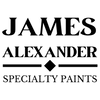With a light and easily applied formula, James Alexander Limewash Paint is a US made, handcrafted natural wall finish that is based on mineral limestone. Limewash is applied with a large block style brush and creates a soft, texturally matte finish with natural movement from the mineral lime.
Our authentic limewash adds an unmatched finishing touch with dimension and depth of color to walls and ceilings. Explore an exclusive and curated range of mineral colors that combine with the natural beauty of limewash paint to create a truly special environment.
About Limewash
Limewash paint, originating from Roman times, is created by burning crushed limestone, adding water, and introducing mineral pigments for color. James Alexander limewash paint is virtually odorless during application and drying.
After application, it absorbs CO2 from the air during a process known as carbonation, transforming into a limestone finish over time. This process contributes to improved indoor air quality.
Limewash is a decorative and rewarding method for enhancing your walls. The brushed application ensures a finish that's uniquely yours, adding a personal touch to your space.

FAQ's
Lime-Prep primer helps to produce a more accurate limwash color finish. Lime-Prep is for interior surfaces only and should be painted over a coat of standard water-based wall primer if the existing wall is unpainted.
Lime-Prep is a bonding primer and will not adequately seal to create an even finish or prevent material or color bleed-though of existing substrates. (new construction or unpainted finishes).
Densifier is a water based, mix-in binder additive that makes interior limewash applications cure to a finish that is more typical in performance to a flat water based wall paint. It will still have the visual movement, texture, and finish of our pure limewash. Densifier reduces the inherent chalky surface finish for areas of wall that may be touched. This is especially helpful to create a practical limewash finish in higher use areas such as hallways, bathrooms and other living areas. Our sealer can be applied over a densified limewash finish for an additional level of protection.
Our interior sealer is a very flat finish with exceptionally low sheen. It allows the surface to be wipeable. There will be a slight sheen increase from using sealer. If you want the surface as flat/matte as possible, adding a sealer may not be desirable. Another benefit of not sealing is that you can touch-up with no prep (if you need to touch up after applying sealer, you will need to apply Lime-Prep primer to the surface before completing the touch-up application). Finally, a consideration is that with deeper colors, the sealer can alter the appearance of the color. If you decide to use sealer, always test in an inconspicuous area before applying to the whole surface to ensure that the visual appearance of the sealer on limewash is acceptable for your project.
Yes, all of our products are water based and are water-clean-up.
With standard paints, VOC (volatile organic compound) emissions occur during paint application and the drying process, and may continue to off-gas even years after application.
It's important to note that even paint labeled as "Low VOC" can emit VOCs, as they are only required to contain less than 50g/l of VOCs, and may still include intentionally added VOC-containing chemicals. Conversely, "Zero VOC" paints must contain less than 5g/l of VOCs, with no intentional addition of VOCs, although trace amounts may be present as residual components of other ingredients.
But what exactly do we mean by trace amounts of VOCs? According to the Federal Trade Commission's guidance on zero-VOC claims, this refers to VOCs that have not been intentionally added to the product and do not cause material harm that consumers typically associate with VOCs. Additionally, the level of trace VOCs must be no more than that which is found as a trace contaminant or background level in the ambient air.
Our limewash and mineral pigments naturally fall under the zero VOC category.
We are committed to providing you with eco-friendly, low-VOC and zero-VOC paints that are designed to enhance your indoor air quality without sacrificing quality or performance.
Yes! One or two applications of various dilution ratios will create a translucent finish. James Alexander Limewash can be diluted with water up to 300 percent of volume to create a nearly transparent wash effect. This is a standard dilution ratio for wood-wash finishes. Wax pastes or water based polyurethanes are sometimes used for protective topcoats in these decorative applications.

